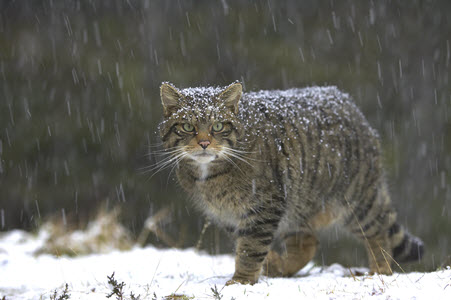The Scottish Wildcat (Felis silvestris silvestris) is one of our most endangered mammals and our only remaining native cat. It urgently needs action to save shrinking populations in the wild. Following habitat loss and persecution through the 19th century, the wildcat is now restricted in the UK to the Scottish Highlands north of the central belt.
Now, the largest-ever survey of Scottish wildcats is underway with more than 300 trail cameras set up to help with monitoring.
The survey focuses on five of the wildcat priority areas of Scotland, including Strathpeffer, Strathbogie, Strathavon, North Strathspey and the Angus Glens. Work will be continuing in Morvern later in the year. As part of Scottish Wildcat Action, these motion-sensitive cameras will monitor cats living in parts of the Highlands over a 60-day period.
Survey methods are informed by published scientific studies and a practical hands-on approach.
More than 130 volunteers will check the cameras. Data gathered will help inform wildcat protection measures including an extensive neutering campaign to stop feral and pet cats from interbreeding with the endangered wildcats and passing disease on to them.
The project would like to send an enormous thank you to all the dedicated volunteers who have given up their time to help gather this crucial intelligence. This impressive volunteer collaboration is supported by an award from the Heritage Lottery Fund.
Dr Aileen McLeod, Minister for Environment, Climate Change and Land Reform, said:“This project will carry out important work to protect the future of the wildcat in Scotland. I look forward to seeing the images from these camera trials and finding out more about these fascinating animals. I would also like to thank all the volunteers involved in helping this project to take place and to cover so much wildcat territory.”
Roo Campbell, the priority areas manager, said: “This is a significant step towards creating safer places for wildcats in Scotland. The winter survey will provide a huge source of information about what cats are out there, where they are and the degree of hybridisation between our native wildcat and the domestic cat. This is the first time a wildcat survey of this scale has been carried out and will be very important for assessing the current threats to wildcats.”
The chief threat to the wildcat is continued interbreeding with domestic cats. Many wildcats in Scotland already contain some domestic cat ancestry and wildcats will continue to become less distinctive if this is left unchecked.
Scottish Wildcat Action is committed to reducing the risk of interbreeding between wildcats and domestic cats or obvious hybrids. Once the situation in the priority areas is better known, the project team can determine appropriate follow-up actions. This includes working with local communities and estates to protect our remaining wildcats and gearing up for a co-ordinated Trap Neuter Vaccinate and Release programme next summer. Unowned domestic cats and obvious hybrids will be trapped, neutered and vaccinated before being returned to the wild under licence from Scottish Natural Heritage.
To find out more about the project and report sightings of any wild-living cats, please visit www.scottishwildcataction.org
You can also see the Scottish Wildcat pages on the Atlas of Living Scotland

